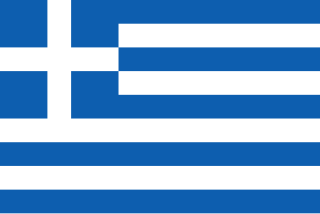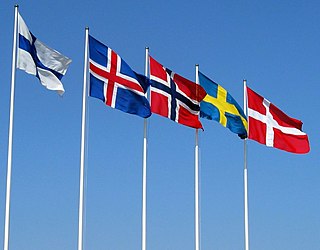
Three successive designs served as the official national flag of the Confederate States of America during its existence from 1861 to 1865.

A saltire, also called Saint Andrew's Cross or the crux decussata, is a heraldic symbol in the form of a diagonal cross, like the shape of the letter X in Roman type. The word comes from the Middle French sautoir, Middle Latin saltatoria ("stirrup").

The national flag of Greece, popularly referred to as the "blue and white" or the "sky blue and white", is officially recognised by Greece as one of its national symbols and has nine equal horizontal stripes of blue alternating with white. There is a blue canton in the upper hoist-side corner bearing a white cross; the cross symbolises Eastern Orthodox Christianity, the established religion of the Greek people of Greece and Cyprus. The blazon of the flag is Azure, four bars Argent; on a canton of the field a Greek cross throughout of the second. The official flag ratio is 2:3. The shade of blue used in the flag has varied throughout its history, from light blue to dark blue, the latter being increasingly used since the late 1960s. It was officially adopted by the First National Assembly at Epidaurus on 13 January 1822.

Tincture is the limited palette of colours and patterns used in heraldry. The need to define, depict, and correctly blazon the various tinctures is one of the most important aspects of heraldic art and design.

The flag of Georgia, also known as the Five Cross Flag, is one of the national symbols of Georgia. Originally a banner of the medieval Kingdom of Georgia, it was brought back to popular use in the late 20th and early 21st centuries during periods of the Georgian national revival. Prior to obtaining its official status in 2004, the flag was popularised by the United National Movement and served as one of the most recognisable symbols of the Rose Revolution.

The flag of Lithuania consists of a horizontal tricolor of yellow, green, and red. It was adopted on 25 April 1918 during Lithuania's first period of independence from 1918 to 1940, which ceased with the occupation first by Soviet Russia and Lithuania's annexation into the Soviet Union, and then by Germany (1941–1944). During the post-World War II Soviet occupation, from 1945 until 1989, the Soviet Lithuanian flag consisted first of a generic red Soviet flag with the name of the republic, then changed to the red flag with white and green bands at the bottom.

The national flag of Turkmenistan features a white crescent and five stars representing the five regions of the country. Placed upon a green field is a symbolic representation of the country's famous carpet industry. It was introduced as the flag of Turkmenistan on September 27, 1992 to replace the Soviet-era flag which consisted of a red background with two light blue bars in the middle. The modified version with a 2:3 ratio was adopted on January 24, 2001.

The coat of arms of Alberta, the heraldic symbol representing the Canadian province of Alberta, contains symbols reflecting Alberta's British heritage along with local symbols. The upper part of the shield features the red cross of Saint George. The lower portion of the shield depicts the Rocky Mountains, grass prairies, and wheat fields - representing Alberta's landscape.

The flag of the Commonwealth of Massachusetts is the flag of Massachusetts. It has been represented by official but limited-purpose flags since 1676, though until 1908 it had no state flag per se to represent its government. A variant of the white flag with blue seal was carried by each of the Massachusetts volunteer regiments during the Civil War alongside the National Colors. An exception were the two "Irish regiments", each of which was permitted to carry an alternative green flag with a harp symbol. The state currently has three official flags: a state flag, a "naval and maritime flag", and a governor's flag. With Florida and Minnesota, it is one of only three state flags to prominently feature a Native American in its heraldry.

The original coat of arms of the Northwest Territories was granted by a Royal Warrant of Queen Elizabeth II on 24 February 1956. The shield is also featured on the territorial flag. The coat of arms was designed by well known Canadian heraldry expert Alan Beddoe in the early 1950s.
Fascist symbolism is the use of certain images and symbols which are designed to represent aspects of Fascism. These include national symbols of historical importance, goals, and political policies.

A roundel is a circular disc used as a symbol. The term is used in heraldry, but also commonly used to refer to a type of national insignia used on military aircraft, generally circular in shape and usually comprising concentric rings of different colours. Other symbols also often use round shapes.

The Nordic cross flag is any of certain flags bearing the design of the Nordic or Scandinavian cross, a cross symbol in a rectangular field, with the center of the cross shifted towards the hoist.

In heraldry and vexillology, fimbriation is the placement of small stripes of contrasting colour around common charges or ordinaries, usually in order for them to stand out from the background, or perhaps just because the designer felt it looked better, or for a more technical reason to avoid what would otherwise be a violation of the rule of tincture. While fimbriation almost invariably applies to both or all sides of a charge, there are very unusual examples of fimbriation on one side only. Another rather rare form is double fimbriation, where the charge or ordinary is accompanied by two stripes of colour instead of only one. In cases of double fimbriation the outer colour is blazoned first. The arms of Mozirje, in Slovenia, show an example of fimbriation that itself is fimbriated.

The most basic rule of heraldic design is the rule of tincture: metal should not be put on metal, nor colour on colour. This means that or and argent may not be placed on each other; nor may any of the colours be placed on another colour. Heraldic furs as well as "proper" are exempt from the rule of tincture. The rule seems to have operated from the inception of the age of heraldry, i.e. about 1200-1215, but seemingly was never written down. It was rather deduced by later commentators as a rule which must have existed, based on the evidence it produced. Although the vast majority of coats of arms ever used across the whole of Europe follow the rule, a very few coats which contravened the rule were borne in the mediaeval era by certain families or corporate bodies for many centuries without effective censure by the heraldic authorities. The reason for the original contraventions and for the toleration of them is unknown, although in the case of the arms of the Kingdom of Jerusalem clearly extreme high status was involved.
In classical heraldry, vert is the tincture equivalent to the colour "green". It is one of the five dark tinctures (colours). The word vert is simply the French for "green". It is used in English in the sense of a heraldic tincture since the early 16th century. In Modern French, vert is not used as a heraldic term. Instead, the French heraldic term for green tincture is sinople. This has been the case since c. the 16th century. In medieval French heraldry, vert also meant "green" while sinople was a shade of red. Vert is portrayed by the conventions of heraldic "hatching" by lines at a 45-degree angle from upper left to lower right, or indicated by the abbreviation vt. when a coat of arms is tricked.

The coat of arms of Kropyvnytskyi is one of the city's symbols reflecting its past and the controversies of its history.

Attributed arms are Western European coats of arms given retrospectively to persons real or fictitious who died before the start of the age of heraldry in the latter half of the 12th century. Arms were assigned to the knights of the Round Table, and then to biblical figures, to Roman and Greek heroes, and to kings and popes who had not historically borne arms. Each author could attribute different arms for the same person, but the arms for major figures soon became fixed.
Vehicle registration plates of Georgia are composed of an embossed serial of two letters, a hyphen, three numbers, a hyphen, and two letters, in black on a white background with a blue vertical strip on the left. The plates are issued in the Latin alphabet. Georgian registration plates are the same size as the most common European registration plate. All plates have the abbreviation "GE" in the lower left corner of the plate and the national flag in the upper left corner. This set of new style registration plates have been in use since 1 September 2014.

The official description of the Coat of arms of Kutaisi is so:

















